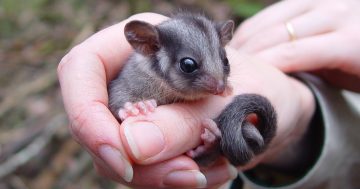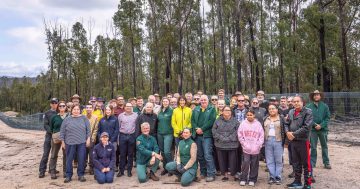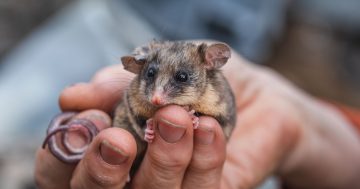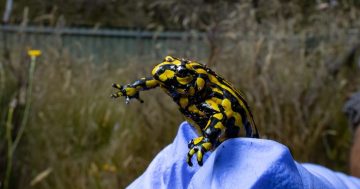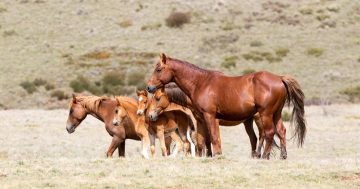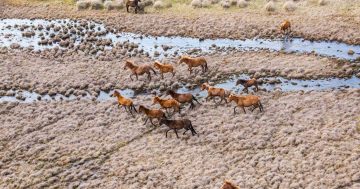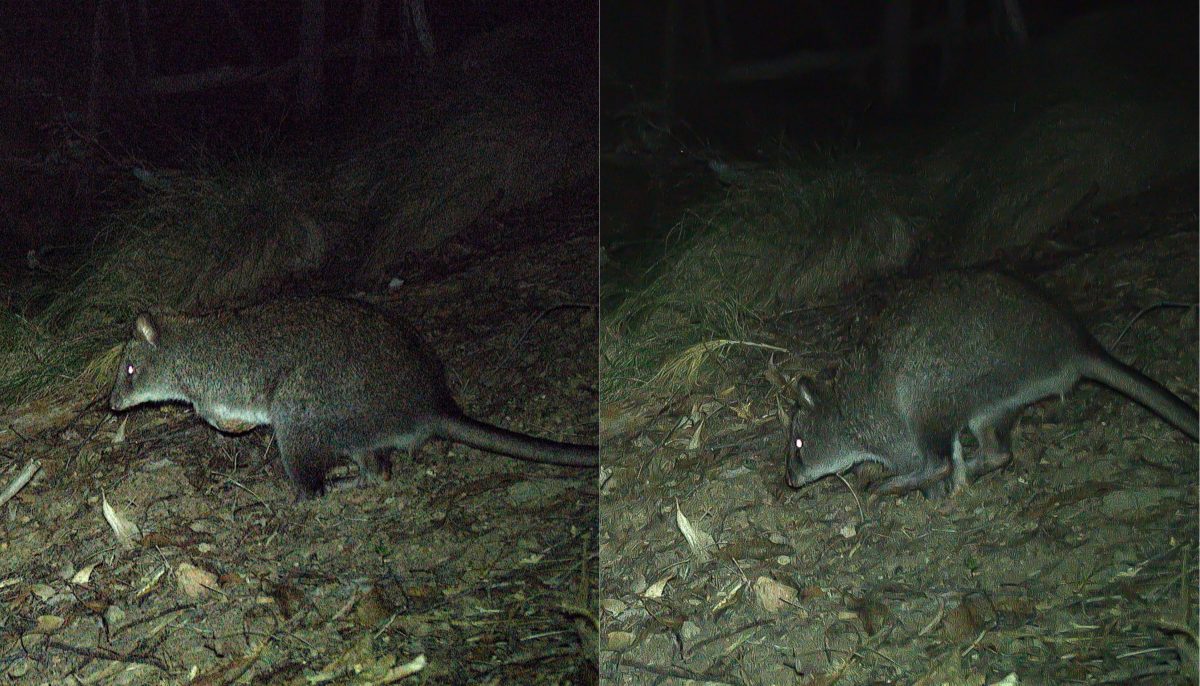
As DCCEEW staff pored through thousands of surveillance photos taken in the remote Byadbo Wilderness in Kosciuszko National Park, they spotted a unique and extremely rare visitor to that part of the woods in this little long-footed potoroo. Photo: NSW NPWS.
A long-footed potoroo – one of Australia’s rarest marsupials – has been photographed in Kosciuszko National Park (KNP), a discovery that has ecologists excited about the secretive species’ survival in NSW.
Dr Doug Mills, senior ecologist with the NSW Department of Climate Change, Energy, the Environment and Water (DCCEEW), said the long-footed potoroo (Potorous longipes) was an adorable small marsupial, usually weighing 1.5 to 2.5 kilograms and often likened in size to a bettong or bandicoot.
“It’s very cute, very endearing,” he said. “There are only three potoroo species in Australia. The long-footed is one, alongside the long-nosed potoroo which is found across NSW, Victoria and Tasmania, and Gilbert’s potoroo in Western Australia.”
While Gilbert’s potoroo is considered Australia’s most endangered marsupial, classified as critically endangered by the International Union for Conservation of Nature, the long-footed potoroo isn’t far behind.
In NSW it is listed as critically endangered, and until recently, it was thought to survive only in the wet forests of far-eastern Victoria, where it is classified as endangered.
Records from the early 1990s, based on hair analysis from fox scats, identified their presence in southern NSW, but repeated surveys failed to find further evidence.
That changed a few years ago when camera surveys detected long-footed potoroos in Bondi State Forest, near Bombala in the far south of the state, marking the first record of the species in NSW in 30 years.
Dr Mills said the latest detection further west, in the rugged and remote Byadbo Wilderness in the Lower Snowy River area of KNP, came earlier this year during the department’s routine cat-monitoring program within national parks.
“One of our team members went through the camera images and spotted something unusual. We looked at it and thought, ‘Could this be a long-footed potoroo?’ It was then confirmed by experts familiar with the species,” he said.
The sighting was about 15 to 20 kilometres north of previously known Victorian populations. While unexpected, it was not completely surprising.
“It raises questions about how dynamic these animals are, how far they move, and whether there might be previously unknown populations in the park,” Dr Mills said.
Potoroo habitat typically consists of wet eucalypt forests with dense understory, providing shelter and abundant food.
However, the Kosciuszko site where the potoroo was recorded was drier than expected, showing the species may not be limited to the wet eucalypt forests where it is most commonly found.
“We have to be careful about assumptions regarding what constitutes suitable habitat,” Dr Mills noted.
Environmental factors may also play a role in the species’ presence.
Recent wetter years have boosted food availability, such as native truffles, which form a large part of the potoroo’s diet.
“Environmental productivity goes up, prey diversity and abundance increase, and that can support populations,” Dr Mills said.
Predation, particularly by foxes, has been a major factor in the long-footed potoroo’s decline.
“Foxes are a big issue and have been implicated in their broader decline, along with habitat fragmentation,” Dr Mills said.
Feral cats may also affect juvenile survival, though the impact on adult potoroos is less clear.
Targeted feral animal control remains a key part of conservation efforts, and the department coordinates its monitoring data with park management teams to optimise protection measures.
The species is generally solitary, with individuals foraging alone and meeting only to mate, making it challenging to estimate populations.
Long-term monitoring, including camera traps and emerging genetic techniques, helps ecologists understand distribution and population dynamics.
Historic evidence also shows that long-footed potoroos were once more widespread.
Sub-fossil bone deposits, often from remains of predators’ meals in caves, indicate that prior to European settlement, the species occupied larger ranges in NSW.
These records, spanning hundreds of years, provide context for current conservation work.
For Dr Mills and his team, the Kosciuszko sighting is both a rare thrill and a call to action.
“It highlights what we don’t know and the importance of ongoing monitoring,” he said.
“We hope to detect them again in the same area this summer to confirm it wasn’t a one-off. Even if we don’t, it emphasises their rarity and the need to be vigilant for other rare species.”
Community involvement can also support conservation.
While the Kosciuszko site is remote, sightings of potoroos in more accessible areas can be reported to Atlas of Living Australia or the NSW Government’s Bionet Atlas, helping ecologists track their distribution.
Public awareness, combined with scientific monitoring, contributes to broader efforts to protect these small, elusive marsupials.
The long-footed potoroo was first described as recently as 1980 (Seebeck & Johnston 1980) but listed as critically endangered in NSW in 2015.
For further information on the long-footed potoroo and other threatened species in NSW visit the NSW Office of Environment and Heritage.







